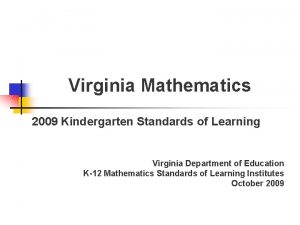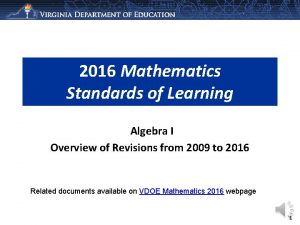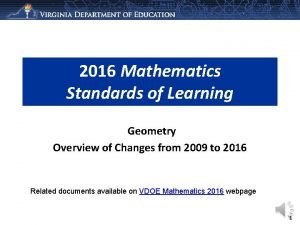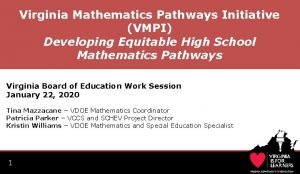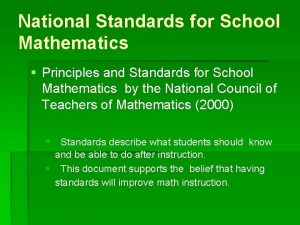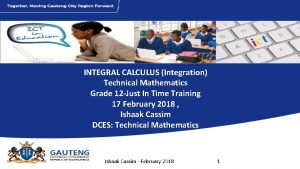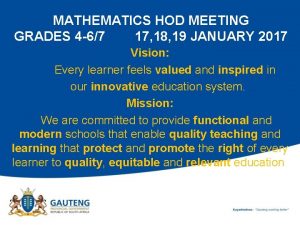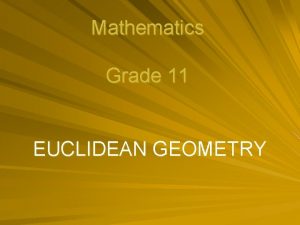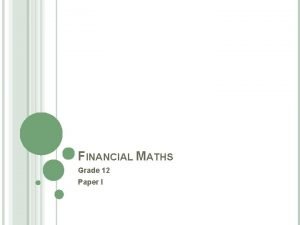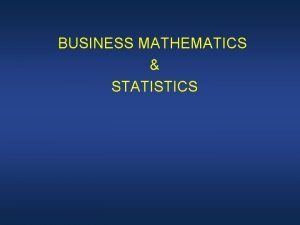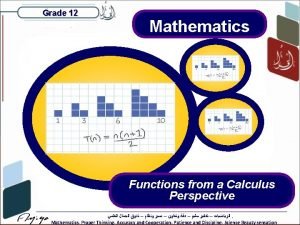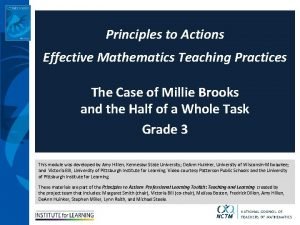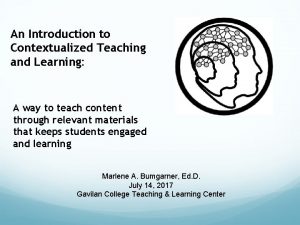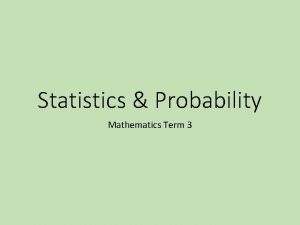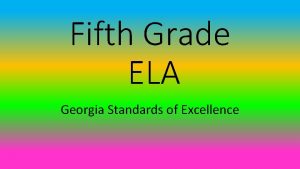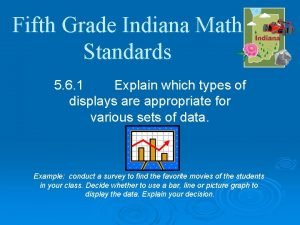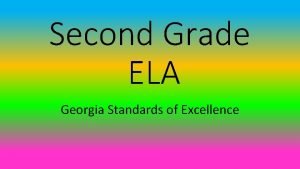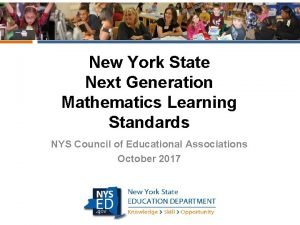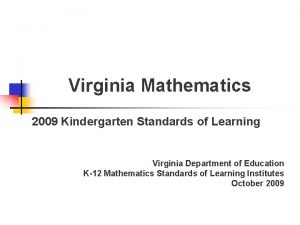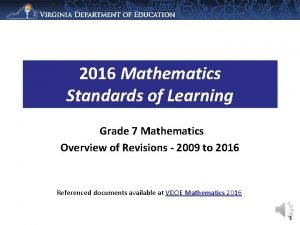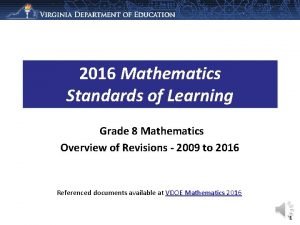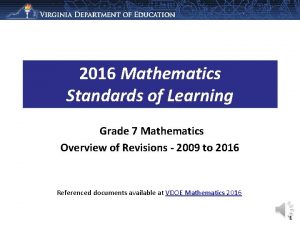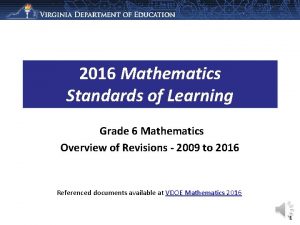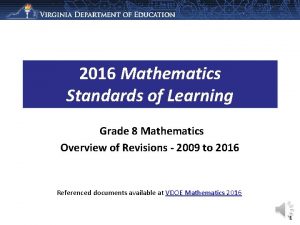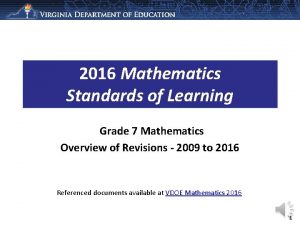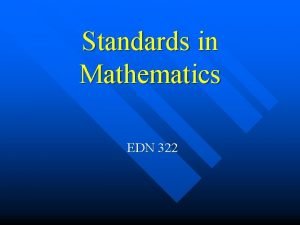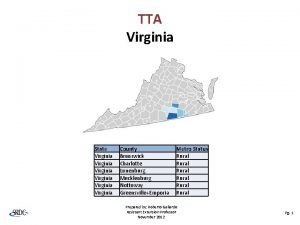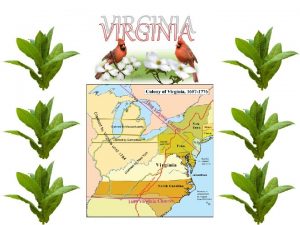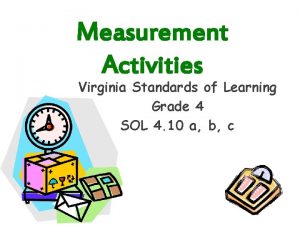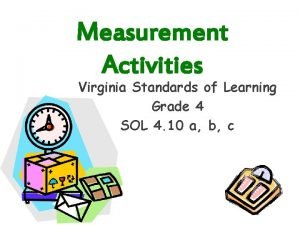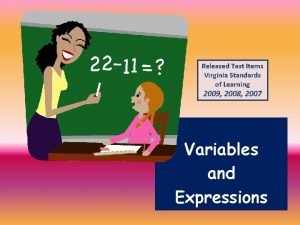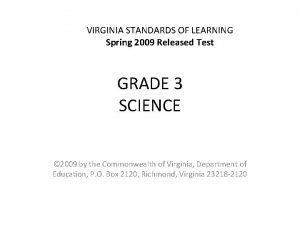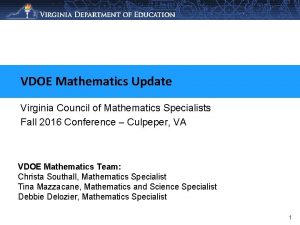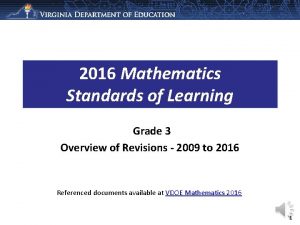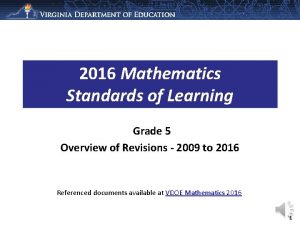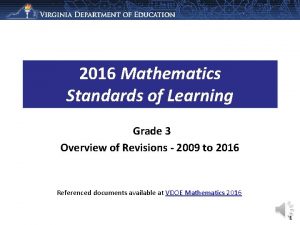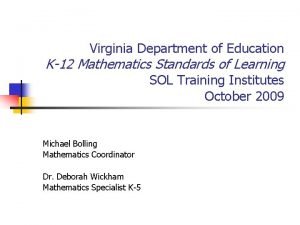Virginia Mathematics 2009 Grade 3 Standards of Learning




























- Slides: 28

Virginia Mathematics 2009 Grade 3 Standards of Learning Virginia Department of Education K-12 Mathematics Standards of Learning Institutes October 2009

Major SOL Changes Number and Number Sense n Mixed numbers. (2001 -3. 5, 3. 6 2009 - 3. 3 a, b, c)

Fractions and Mixed Numbers Understand define the whole Understand that the denominator tells the equal parts that represent a whole Understand that the numerator is a counting number

Number and Number Sense: Understand that the value of a fraction is dependent on both the number of parts in a whole and the number of those parts being considered. Fractions are NOT LIMITED.

Mixed Numbers =1 What is the fractional value of the model shown below?

NO DECIMALS If = 1

Place Value and Using Base-10 blocks unit block flat rod

Major SOL Changes Computation and Estimation n Multiplication and division facts through 12. n Multistep problems using addition and subtraction. n Find related quotients. n Represent multiplication and division, using area, set, and number line models. n Add and subtract with proper fractions having like denominators of 12.

Multiplication and Division Facts through 12 Begin instruction concretely using an ARRAY, set, and number line models. Example: Array model ( 4 x 12) n 4 12 48

Multiplication and Division Facts through 12 Begin instruction concretely using an array, SET, and number line models. Example: Set Model 4 x 12 would be read as 4 “groups of” 12. Using Base-10 to create this set model: 48

Multiplication and Division Facts through 12 Begin instruction concretely using an array, set, and NUMBER LINE models. Example: NUMBER LINE MODEL 0 12 24 36 48 The number line model for 4 x 12 is represented as 4 “jumps of” 12, which is 48.

Computation and Estimation Practical Problems. . including multistep problem solving Example: Jackson baked 12 cookies. His mom baked 24 more cookies. Then Jackson ate 3 cookies for a snack. How many cookies were left after Jackson ate his snack?

Adding and Subtracting PROPER Fractions Understanding the meaning of a PROPER fraction Understanding the meaning of an IMPROPER fraction. Example: ? ? 3 7 4

Major SOL Changes Measurement § Measure length — including part of an inch (1/2). n Use U. S. Customary and metric units to measure perimeter and area. n Measure the distance around a polygon in order to determine perimeter and count the number of square units needed to cover a given surface in order to determine area. § Determine elapsed time in one-hour increments over a 12 -hour period. § Use of standard units.

Measure length — including part of an inch (1/2). 1 2

Perimeter and Area the actual measure of area or perimeter Perimeter Area 5 inches 3 inches What is the perimeter of the figure? 4 units What is the area of the figure?

Geoboards

Elapsed Time Determine elapsed time in ONE-HOUR increments over a 12 -hour period. Times DO NOT cross between a. m. to p. m. Example: Montey wakes up at 6: 00 a. m. He eats breakfast at school at 8: 00 a. m. How many hours will pass from the time Montey wakes up before Montey eats breakfast? 1 hour 6: 00 a. m. 1 hour 7: 00 a. m. 8: 00 a. m.

Elapsed Time Determine elapsed time in ONE-HOUR increments over a 12 -hour period. Times DO NOT cross between a. m. to p. m. Example: Mary gets home from school at 4: 30 p. m. She will eat dinner one hour from the time she gets home. What time will Mary eat dinner?

Major SOL Changes Geometry n Compare and contrast characteristics of plane and solid figures. n Identify and draw representations of points, rays, and lines. n Identify and describe noncongruent twodimensional figures.

Points, Line Segments, Rays, and Angles Understand that POINTS make up a line. Understand that a LINE continues indefinitely in two directions. Understand that a ray is part of a line with one endpoint and continues indefinitely in one direction.

Non-congruent two-dimensional figures Understand that the spatial orientation of the figure does not affect the congruency. Congruent Non-Congruent

Probability as Chance Probability and Statistics Concept of probability as chance. There are 12 tiles in the bag. Five tiles are green and seven tiles are red. What is the probability of reaching into the bag without looking and pulling out a red tile?

Major SOL Changes Patterns, Functions, and Algebra n Identify examples of the identity and commutative properties for addition and multiplication.

Identity and Commutative Properties of Addition and Multiplication Identity Properties Addition 0+2=2 5+0=5 Commutative Properties Addition 5+4=9 4+5=9 Multiplication 1 x 3=3 6 x 1=6 Multiplication 2 x 3=6 3 x 2=6 Recognize that the equals sign ( ) relates equivalent quantities. Recognize that the not equal sign ( ) relates nonequivalent quantities.

Major Format Changes Related SOL have been combined to create one SOL with bullets. EX: (2001) 3. 1 The student will read and write six-digit numerals and identify the place value for each digit. 3. 2 The student will round a whole number, 9, 999 or less, to the nearest ten, hundred, and thousand. 3. 3 The student will compare two whole numbers between 0 and 9, 999, using symbols (>, <, or = ) and words (greater than, less than, or equal to). (2009) 3. 1 The student will a) read and write six-digit numerals and identify the place value and value of each digit; b) round whole numbers, 9, 999 or less, to the nearest ten, hundred, and thousand; and c) compare two whole numbers between 0 and 9, 999, using symbols (>, <, or = ) and words (greater than, less than, or equal to).

Major Format Changes Details on instructional strategies have been removed for potential placement in the curriculum framework. EX: (2001) 3. 4 The student will estimate solutions to and solve single and multistep problems involving the sum or difference of two whole numbers, each 9, 999 or less, with or without regrouping using various computational methods, including calculators, paper and pencil, mental computation, and estimation. [Move to Curriculum Framework] (2009) 3. 4 The student will estimate solutions to and solve single-step and multistep problems involving the sum or difference of two whole numbers, each 9, 999 or less, with or without regrouping.

Grade 3 2009 Proposed Math Curriculum Framework
 Virginia kindergarten standards
Virginia kindergarten standards 2016 mathematics standards of learning
2016 mathematics standards of learning 2016 mathematics standards of learning
2016 mathematics standards of learning Virginia equity math
Virginia equity math Smart seo plugin joomla
Smart seo plugin joomla Principles and standards for school mathematics
Principles and standards for school mathematics 2009 delmar cengage learning
2009 delmar cengage learning 2009 delmar cengage learning
2009 delmar cengage learning Chapter 1 introduction to medical terminology answer key
Chapter 1 introduction to medical terminology answer key 2009 delmar cengage learning
2009 delmar cengage learning Chapter 6 the skeletal system answer key
Chapter 6 the skeletal system answer key Chapter 13 medical math
Chapter 13 medical math Chapter 10 cultural diversity
Chapter 10 cultural diversity Cuadro comparativo de e-learning b-learning y m-learning
Cuadro comparativo de e-learning b-learning y m-learning Grade 12 integration
Grade 12 integration Atp maths grade 4
Atp maths grade 4 Tan chord theorem grade 11
Tan chord theorem grade 11 Grade 12 maths finance
Grade 12 maths finance Business math grade 11 module 3
Business math grade 11 module 3 Mathematics functions grade 12
Mathematics functions grade 12 Establish mathematics goals to focus learning
Establish mathematics goals to focus learning What is contextualized learning
What is contextualized learning Learning intentions and success criteria for mathematics
Learning intentions and success criteria for mathematics 4th grade va studies sol
4th grade va studies sol Factors determining service standards
Factors determining service standards Elagse
Elagse Indiana 3rd grade math standards
Indiana 3rd grade math standards Georgia ela standards 2nd grade
Georgia ela standards 2nd grade Next generation learning standards nys
Next generation learning standards nys
